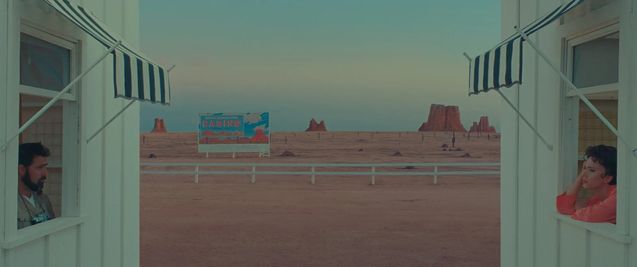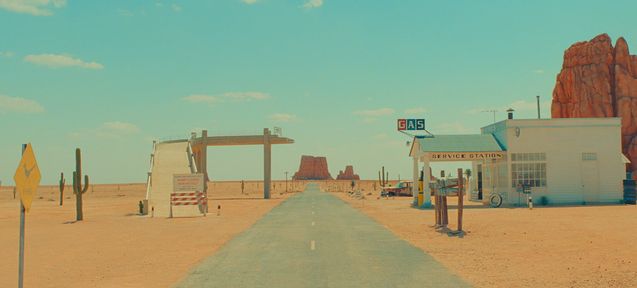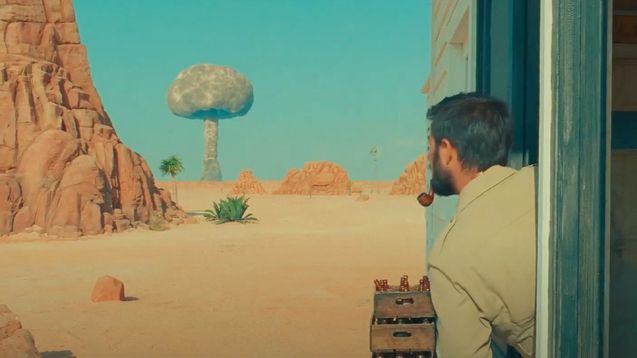ID card
From Moonrise Kingdom, each new feature film by Wes Anderson seems more “Wes Andersonesque” than the previous one, which allowed the filmmaker to achieve a form of delight with The Grand Budapest Hotel, before falling into austerity with The French Dispatch. In this tenth hard-hitting, not to say discouraging, feature film, the filmmaker has compiled all his obsessions for a dizzying rendering, but which neglects what has always breathed life into his cardboard and paste models. authenticity to its most artificial characters: its great sensitivity.
The French Dispatch therefore seemed to predict that the variegated universe of Wes Anderson was going to withdraw into itself, as if symmetry and pastel colors camouflaged the difficulty of renewing itself after having gone around his art. And at first sight, Asteroid City seemed on track to continue the self-caricaturebetween its filmed theater looks, its retro patina, its tongue-in-cheek acting, its multitude of characters impossible to characterize, its disjointed dialogues and its cryptic plot complicated to disentangle.
First layer of the mise en abyme
As expected, Asteroid City is indeed another mosaic of all the motifs of Anderson’s cinema, in particular visuals: lateral traveling shots, compositions of manic shots, enhancement of models, stop-motion technique, changes in image ratios, black inserts and white and sophisticated suits. Rounding out the best of, the film also returns to character archetypes (immature adults and gifted children), as well as storytelling habits with Bryan Cranston’s narrator, a mise en abyme and a breakdown of the scenario into three acts which push the detail to the parentheses in the French subtitles by way of stage directions.
Faithful to his chimeras, Wes Anderson thus offers a new universe of the most cinematic, refined and demanding, and reaffirms in fact an ultra codified and outrageous style, but not irrefutable for all that.
 Last start of the mise en abyme
Last start of the mise en abyme
AND THE CREATED MAN
By isolating the characters, by interning them in a miniature city lost in the middle of the desert and placed in military quarantine, they find themselves symbolically prisoners of the plastic obsessions of the filmmaker until they come out by force. A way of questioning his work and shaking up his certainties, like when the film subtly replays a scene between Jones Hall and his wife, which was not supposed to exist or be kept in the edit.
Asteroid City, which would however be difficult to consider as a city, is only crossed by a single road. The rails of the train seem to encircle it with no starting or ending point, the bridge has never finished being built and the observatory is literally placed above a huge thousand-year-old hole. It is a vain place, as depopulated as it is absurd, and the plot is only a pretext to fill it and animate it. But for what purpose, if not to better confront its visitors with their vanity and empty life?
In this triple mise en abyme, the character of Scarlett Johansson is the one who gets bogged down the most, the actress (formidable by the way) playing a theater actress who plays a film actress who is preparing for a new role is stuck somewhere share between Marilyn Monroe and Audrey Hepburn. Something to get lost in, and that’s the whole point.
Wes Anderson’s films require scratching their varnish, twisting their parallel lines and disturbing their too established order to reach the knots of the protagonists, those very ones, in the case of Augie/Jones and Midge/Mercedes , who fear not to feel anything anymore, to drown in their own fiction without being able to distinguish the real and the concrete.
Both have moved away from the essentials to devote themselves to their work (images on one side and performance on the other), but gradually fill their loneliness and the void around them, first by speaking across a large table, then through the windows of two bungalows. Without realising it, this time they create something invisible, but essential: the link.
 The most beautiful moments of the film are also the simplest
The most beautiful moments of the film are also the simplest
This impasse and this isolation which paralyze and this investment which brings us together could here again refer to the aspirations of the artist, to his irrepressible need to create from nothing, like an artistic and professional bulimia. Even if it means running empty and taking the risk of disinteresting the public in places, like unoccupied land that no one buys, like unoccupied spectator seats.
Asteroid City therefore evokes in subtext the doubts and uncertainties linked to creation, whether it is a question of writing stories (Edward Norton), designing sets (Adrian Brody) or transmitting emotions (Scarlett Johansson). The film is placed on both sides of the curtain, while the characters are the fragments of a single whole, ofthe same work that is written before our eyes, and contemplates the void facing the stage.
 The frame within the frame, the story within the story
The frame within the frame, the story within the story
the unknown
In Asteroid Citythe main plot is thwarted from the start, when the presenter explains that this piece designed especially for the show has never been mounted. So we are witnessing an endless spectacle. But the most confusing are the sub-plots which also lead nowhere, be it a budding romantic relationship or a visit from an alien. The acts follow each other in an unpredictable way, without any real coherence or finality, which does not prevent Jones Hall from looking for meaning in all this and worrying that he still does not understand the play.. To which one of the characters behind the scenes replies that it doesn’t matter, that the important thing is to continue to tell, to continue the play even without knowing where it is going.
In other words, a very explicit metaphor for life itself. The horizon, generally synonymous with the future, is disturbed here by nuclear tests and the shadow of a new war against the background of the space race. To this concrete apprehension are added the characters’ existential questions about death, life after death and our place in the universe.
Like a series of wagons that form a train, this questioning of what is above our heads also sends the characters back to their twisted relationship to others and to the unknown of which the alien is only an incarnation.
Falling in love, becoming friends, revolting and reconciling: these are all common threads in Anderson’s work and all that the protagonists would not have taken the time to do under other conditions. And because there is always something optimistic and comforting in Wes Anderson’s films, Asteroid City ends on the need to simply get back on the road, to get out of isolation, and to tackle another project, even if the previous one is not perfectly completed. Enough to wait enthusiastically for his next medium-length film, The wonderful story of Henry Sugar who will probably give a new impetus to his filmography.




